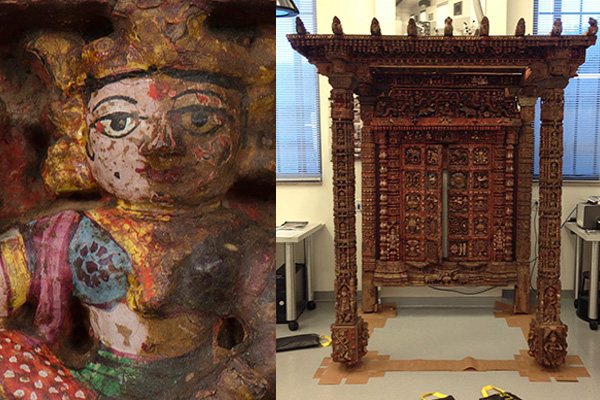
500-Year-Old Jain Shrine Meticulously Restored at the Nelson-Atkins Museum
- By Alison Lesley --
- 28 Jul 2014 --

photo: Nelson-Atkins Museum of Art
Historians at the Nelson-Atkins Museum have finally unearthed a centuries old Jain Shrine.
A Jain shrine dating from 16th century India is now on display at the Nelson-Atkins Museum of Art in Kansas City. The intricately carved and painted shrine has been restored to its former glory by a dedicated team of conservators, who spent many hours and used thousands of swabs delicately cleaning it. Inch by inch, centuries of dirt and grime were removed using gentle solvents, slowly revealing the beautiful and detailed woodwork underneath.
A research team used carbon dating and other advanced techniques to determine the age of the shrine and its components, dating it back over five centuries. It appears that the shrine was repainted sometime in the 1700s. The restoration revealed that most of the paint was still intact, highlighting the colorful beauty of the carved reliefs and painted woodwork. Although the shrine is missing its original roof, a replica was copied from a similar shrine, giving viewers an impression of what the worship site would have looked like in its original form.
Jainism is an ancient religious tradition which dates back almost three millennia and possibly even longer, making it one of the oldest extant religions in the world. While it was dominant on the Indian subcontinent for centuries and was the official religion of various Indian kingdoms, Jainism has been in decline since the 8th century AD due to suppression by Hindu and Muslim sects. There are currently about five million Jains worldwide, with over four million residing in India.
Jain virtues include honesty, nonviolence, sexual restraint (up to and including complete chastity), and asceticism. By rejecting worldly attachments and embracing simple living, Jains hope to cleanse the self of bad karma in order to achieve spiritual perfection and break the chain of reincarnation (samsara). One who has achieved this, and for whom many shrines such as the Nelson-Atkins specimen are dedicated, is called a Jina. Jina translates to “victor” or “conqueror,” meaning that the person has triumphed over his or her bodily passions. The term “Jainism” itself comes from the Sanskrit word jin, meaning “to conquer,” referring to the battle that Jainists do with earthly pleasures and personal desires.
Interestingly, the shrine has been in the museum’s possession for over 80 years. First obtained in 1932, it has remained in storage and was only recently selected for restoration and display. The museum’s original records describe the piece as a “pulpit,” indicating that the purchasers were not aware of the shrine’s significance and rarity – this example is only one of seven known examples in the United States. The Nelson-Atkins shrine will remain on display until June 2015.

















